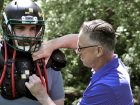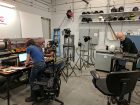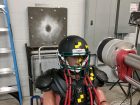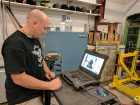
Doctor inventor
Stefan Dubowski
Features Leadership Profession annex chiropractic concussionChiropractor devises gear to help protect football players – and their brains.
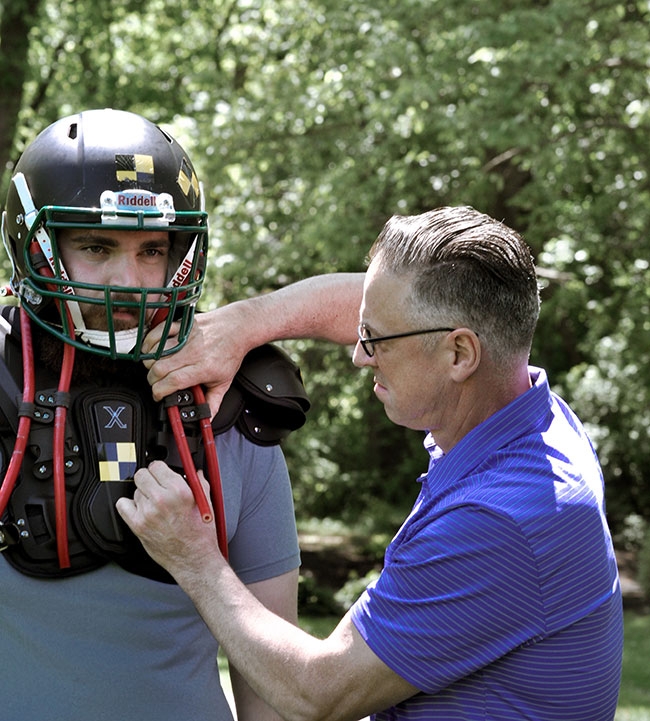 Dr. Kevin Jackson (right) tests the force absorption system, which connects to the helmet and shoulder pads that football players use.
Dr. Kevin Jackson (right) tests the force absorption system, which connects to the helmet and shoulder pads that football players use. A pioneering chiropractor with a Canadian pedigree has invented protective sports gear to help football players reduce the risk of concussions.
Over the last five years, Dr. Kevin Jackson has been developing The Jackson Force Absorption System, which absorbs the energy during collisions that players commonly experience on the field.
When players get hit, they can be seriously hurt, notes the Jackson Athletic website. It explains, “Excessive linear or rotational forces in the form of cervical rotation, lateral bending, extension and flexion cause the cervical facet joints to ride up on each other and jam. This can cause the posterior longitudinal ligament to stretch beyond its limits. As a result, the spinal cord, spinal nerve roots, blood vessels and cerebral spinal canal are traumatized to some degree. This trauma can create the same neurological symptoms of a brain concussion. It may contribute to the long-term neurodegenerative changes seen in football players.”
Down the tube
The Jackson Force Absorption System uses rubber tubes to help soak up the energy otherwise relayed to the player’s cervical spine, brainstem, spinal cord and blood vessels. The tubes connect to the helmet and the shoulder pads, effectively stopping the player’s neck from overextending. The system clips easily into place, and it’s adjustable to fit players of various shapes and sizes. A range of coloured resistance bands work for players at different levels: purple for peewee, yellow for high school, red for college and green for professional.
A BSc graduate of Brock University in St. Catharines, Ont. and DC grad of Life University in Marietta, Georgia, Jackson operates Sigafoose & Jackson Chiropractic in York, Pennsylvania, one of the largest clinics in the state. He traces the idea for the Jackson Force Absorption System back to his rugby-playing days, circa 1987 on the Life campus. He collided with a teammate during practice and got a concussion: experiencing dizziness, headaches and ringing in his ears. He was still suffering even after a few months later. One of his teachers recommended getting his upper cervical checked, so Jackson went to see Dr. John Grostic, who specialized in that area. Jackson’s symptoms disappeared almost immediately after treatment.
That quick turnaround spurred his interest in the link between the upper neck and concussion-related symptoms. Over time, Jackson’s focus on this area grew.
“Being a football and hockey fan, when I watched games and I’d see guys getting hit and wind up with concussion symptoms, I noticed that sometimes the hit was body to body. That got me thinking there must be a cervical component — and wouldn’t it be great to have a piece of equipment to protect excessive movement in the neck?”
So over time, Jackson developed prototypes for just such a product. Meanwhile, researchers were publishing more and more papers indicating that neck trauma can lead to symptoms nearly identical to those of a concussion. Jackson points to one notable study, “The Role of the Cervical Spine in Post-Concussion Syndrome,” published July 2015 in The Physician and Sportsmedicine. The authors – Drs. Cameron Marshall, Howard Vernon, John Leddy and Bradley Baldwin – found that it takes 96.1g of force to cause a concussion but just 4.5g to put a torque or torsion on the upper cervical area.
Jackson says the fact that such low-intensity impacts are common suggests they could account for many of the concussion symptoms players exhibit.
Testing underway
Jackson recently finished a round of testing for his system at a facility in Belcamp, Maryland. He was looking into axial compression, to make sure the coloured bands built into the product don’t create a downward force on the cervical spine. The testing results have not been completely formalized as of press time, but Jackson says preliminary outcomes are “extremely encouraging.”
“One of the objectives of the prototype being tested this time was to measure any detrimental force or movement the system may create as a result of the rubber tubing absorbing energy from a collision. In other words: Does the force and movement that’s absorbed during a football collision create potential energy to injure the skull or cervical spine of the player wearing the equipment?”
During testing, the test dummy had load cells placed strategically in the skull and cervical spine area. The force and movement test creates a measurement called the headform severity index (HSI).
“The standard for sports equipment safety is a HSI of 1,000 or below. The prototype tested well below the safety threshold and seems to lower the HSI. The good news is that in early test results it appears the prototype doesn’t create a potential source injury for the wearer,” Jackson notes.
He figures the project has cost about $95,000 for patenting, prototyping and testing so far. Most of that money has come out of his pocket. “I’ve been fortunate enough in my practice, so I can afford the testing and the manufacturing of the prototypes. Life University has become a partner and has offered to give financial support. In fact, they paid for the last tests. But I just don’t want to involve anybody else until I’m sure it’s a viable product.”
Jackson isn’t working alone, though. He has a development team, including Dr. Kristen Willeumier, a Los Angeles-based neuroscientist who specializes in how the brain is affected by health, nutrition and the impact of concussions. She led a clinical research trial investigating the long-term effects of repetitive subconcussive impacts in NFL players. For Jackson, she’s a consultant who reviews the test data and will help produce a manuscript for publication.
Willeumier points out that more than a million children play football in the U.S. Many of those youngsters experience subconcussive impacts as they play.
“You have kids who start out in peewee football and go through high school, college and their brain function is seemingly intact. But they might get a degenerative brain disease sooner than someone in the general population, and we’re seeing this with our professional athletes.
“If we can reduce the subconcussive impacts by even 10 per cent, that could mean someone won’t get a degenerative disease or the symptoms of it.”
Weighing in
Dr. John Crawford says the system is a good step forward — but he does have a couple of caveats. Crawford is a chiropractic sports sciences specialist at Shift Rehabilitation At Arbour in Guelph, Ont., and associate professor at Canadian Memorial Chiropractic College (CMCC) in Toronto.
He believes the work Jackson is doing makes sense as far as reducing damage to the cervical spine goes. But even if Jackson’s system fully protects that area of the body, “there’s no way to put a seatbelt on the brain,” Crawford says. In other words, even if the cervical spine is kept from overextension, the brain could still receive a rattle – which means damage from concussions will continue to be a problem.
Another concern is that the better the protective equipment, the more chances players will take. Today’s gridiron gladiators are bigger and stronger than players of the past. The equipment they wear is more shock absorbing, too.
“Because they have so much protection, they feel they’re invincible,” Crawford says. “If you have a linesman wearing this system, he might think: ‘I can hit that guy harder because my neck is protected.’”
That said, players and the public are better informed about the risks of concussion, thanks in part to high-profile concussion cases such as the one that sidelined hockey star Sidney Crosby a few years ago. Rowan’s Law might be the most poignant example. It is legislation in Ontario designed to reduce concussions in youth sports. The law is named after Rowan Stringer, an Ottawa high school rugby player who, in 2013, suffered two concussions and died a few days later.
Crawford says people are more concerned about concussions and other dangers associated with contact sports. Modern attitudes are a lot different than they were when he played football. “I was taught that our facemask was a weapon and we should drive it into the numbers on the jersey of the player in front of us.”
The juggling act
Jackson seems poised to capitalize on the higher level of concussion awareness among players and the public. But remember, he isn’t just an inventor. He’s also a clinician, running a business.
“That’s why it’s been a five-year project,” he says. “I devote maybe five, six hours a week to it. Usually when I’m sitting down to watch any sports on TV, I’ll work on it. If my hands are free and my brain is free, I might as well put time into that.”
Jackson still has work to do. He has to get the product certified with a number of government safety organizations before he can test it on human subjects. Then come questions about the best way to manufacture, distribute and market the system. Despite the challenges ahead, however, this chiropractor seems optimistic.
“I would say that if the next round of testing indicates no stress or strain that would be a pathological factor for the cervical spine. Then probably within the next year we’ll have a product.”
STEFAN DUBOWSKI is an award-winning freelance writer based in Ottawa.
Print this page
